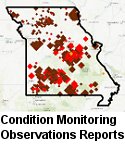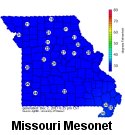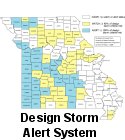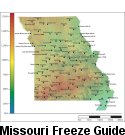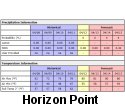
Missouri Frost Line
Pat Guinan
State Climatologist
Commercial Agriculture/University of Missouri Extension
Many factors such as air temperature, snow cover, ground cover, soil type, soil moisture etc. will determine how deep the frost line penetrates but some long term soil temperature observations for the state can be utilized to get a general idea. There are only a handful of sites that have established official records of soil temperatures at multiple depths in Missouri. These sites include Spickard (Grundy county), Columbia (Boone), and Mount Vernon (Lawrence). Soil temperature observations at these University of Missouri Agricultural Experiment Stations began in 1967 and are collected at various depths including under a bare soil at a depth of 2 inches and under a sod at 4, 8, 20 and 40 inches.
Using the historical soil temperature records for the three aforementioned regions in Missouri, we can get a general idea of how deep the frost line has penetrated in the past 43 years. For northern Missouri, in Spickard, the coldest 8-inch soil temperature was 29° in 1977 and 1982 and the coldest 20-inch temperature was 35° in 1977, 1978 1994 and 1997. The coldest 40-inch temperature was 37° in 1986 and 1994. In mid-Missouri, the frost line at Columbia has also never reached the 20-inch depth. The coldest temperature at 20 inches was 35° in 1996, and the coldest 40-inch temperature was 42° in 1978. The coldest 8-inch temperature was 28° in 1982 and 1996. Soil temperature records in southern sections of the state indicate the frost line has never reached the 20-inch depth at Mount Vernon. The coldest temperature at the 8-inch depth was 28° in 1979 and the coldest 20-inch temperature was 36° in 1977 and 1979. The coldest 40-inch temperature was 40° in 1979.
Fortunately, during most bitterly cold outbreaks, Missouri will have a blanket of snow. Snow is an excellent insulator and will prevent freezing temperatures from penetrating too deep into the soil surface. There have been occasions, however, where minimal snow cover (less than 1-inch) was on the ground and an arctic outbreak ensued. In fact, the coldest outbreak on record for Missouri occurred between February 8-12, 1899 when the average statewide temperature was -6°F, or 40 degrees below normal! During this time, most of east central, south central, and southeastern Missouri had an insulating blanket of snow but northern and western sections reported bare ground. Actual soil temperature records were not taken at this time but a subjective report from an observer in Oregon, MO stated the ground was frozen 2-3 feet deep!


